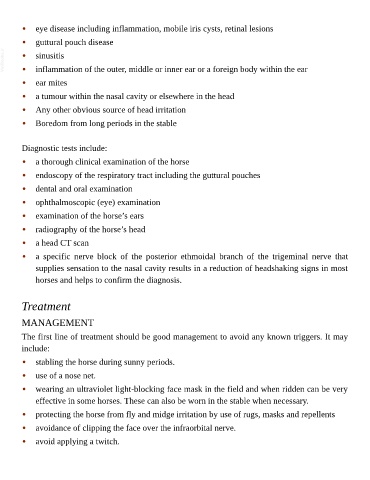Page 519 - The Veterinary Care of the Horse
P. 519
• eye disease including inflammation, mobile iris cysts, retinal lesions
• guttural pouch disease
VetBooks.ir • sinusitis
•
inflammation of the outer, middle or inner ear or a foreign body within the ear
• ear mites
• a tumour within the nasal cavity or elsewhere in the head
• Any other obvious source of head irritation
• Boredom from long periods in the stable
Diagnostic tests include:
• a thorough clinical examination of the horse
• endoscopy of the respiratory tract including the guttural pouches
• dental and oral examination
• ophthalmoscopic (eye) examination
• examination of the horse’s ears
• radiography of the horse’s head
• a head CT scan
• a specific nerve block of the posterior ethmoidal branch of the trigeminal nerve that
supplies sensation to the nasal cavity results in a reduction of headshaking signs in most
horses and helps to confirm the diagnosis.
Treatment
MANAGEMENT
The first line of treatment should be good management to avoid any known triggers. It may
include:
• stabling the horse during sunny periods.
• use of a nose net.
• wearing an ultraviolet light-blocking face mask in the field and when ridden can be very
effective in some horses. These can also be worn in the stable when necessary.
• protecting the horse from fly and midge irritation by use of rugs, masks and repellents
• avoidance of clipping the face over the infraorbital nerve.
• avoid applying a twitch.

